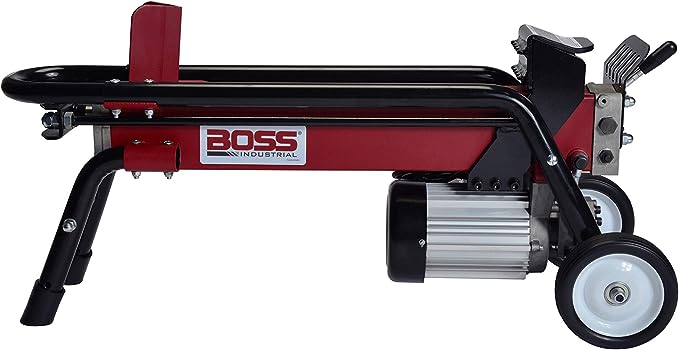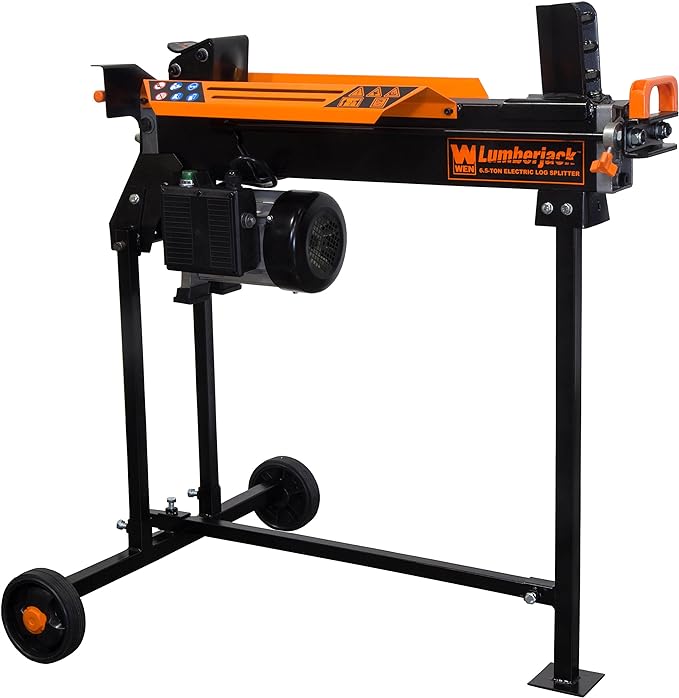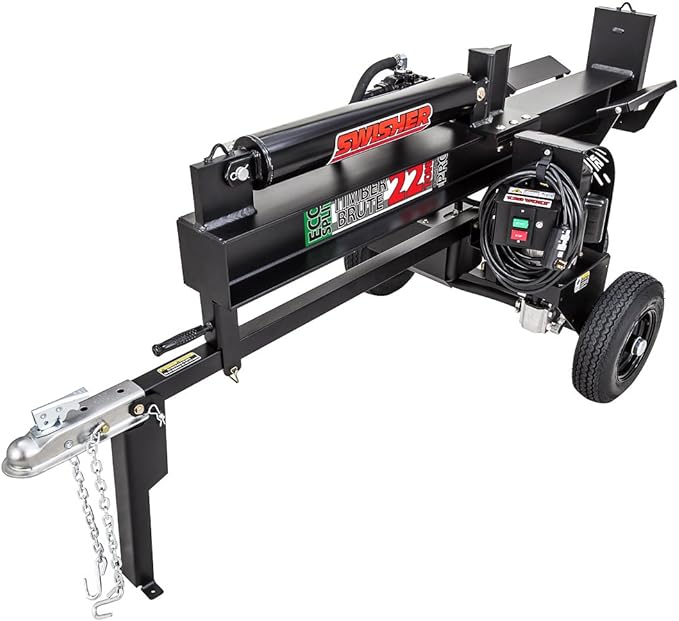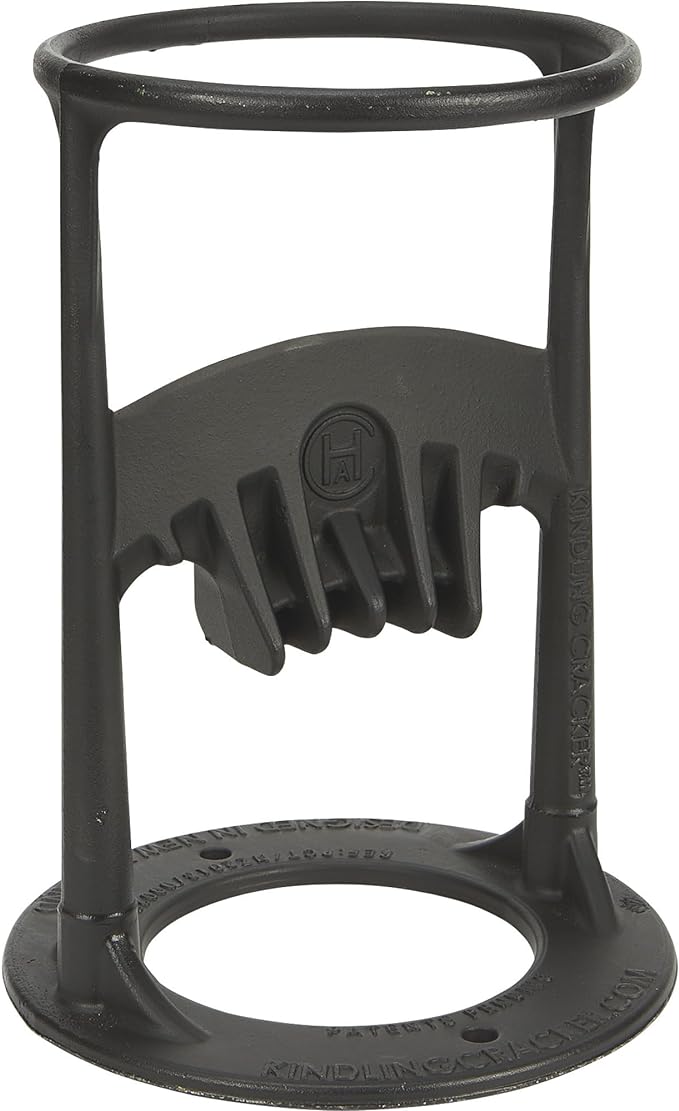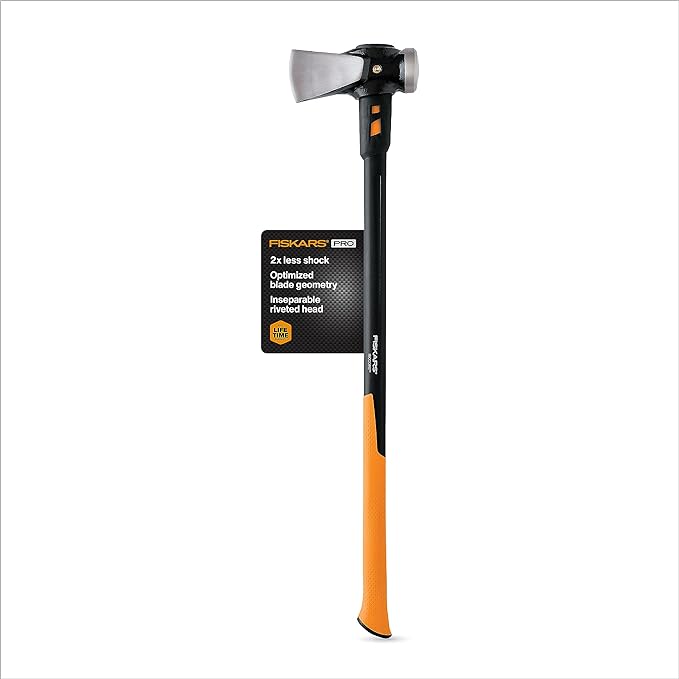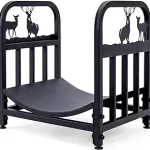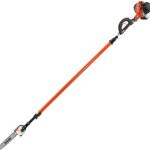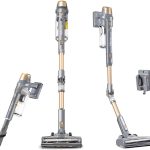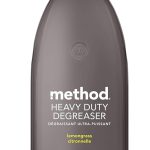You might be surprised to learn that the average American burns over 200 pounds of firewood per year, and that’s where log splitters come in – to make the process efficient and convenient. When it comes to choosing the right one, you’re faced with a plethora of options, each boasting its own unique features and benefits. From electric log splitters like the ES7T20 and WEN 56208, to manual options like the ESTWING Sure Split Wedge, the choices are endless. But which ones are truly the best? You’re about to find out.
Contents
- ES7T20 Electric Log Splitter, 7-Ton
- WEN 56208 6.5-Ton Electric Log Splitter with Stand
- ESTWING Sure Split Wedge
- YARDMAX YS0952 9 Ton Log Splitter
- Swisher Timber Brute Eco Split Electric Log Splitter
- Firewood Splitter Wood Splitter Wedge
- Fiskars IsoCore 8lb. Wood Splitting Maul
- Factors to Consider When Choosing Log Splitters
- Frequently Asked Questions
- Conclusion
ES7T20 Electric Log Splitter, 7-Ton
If you’re looking for a powerful and compact log splitter that can handle small to medium-sized logs with ease, the ES7T20 Electric Log Splitter, 7-Ton is an excellent choice, boasting a 2 HP electric motor that packs a punch with 7 tons of splitting force.
You’ll appreciate its convenient one-handed operation and automatic ram return, making it easy to use and maneuver.
Weighing 121 pounds, this log splitter is relatively lightweight and has a compact design, making it easy to store.
With a 2-year residential warranty, you can have peace of mind knowing you’re protected in case anything goes wrong.
Plus, its quiet operation and lack of fumes make it a great choice for those who value a more pleasant splitting experience.
Best For: Those who need a compact and powerful log splitter for small to medium-sized logs, particularly for use with woodstoves or outdoor fire pits.
Pros:
- Small footprint and lightweight design make it easy to store and maneuver
- Powerful 7-ton splitting force and quiet operation make it a pleasant experience
- Convenient one-handed operation and automatic ram return simplify the splitting process
Cons:
- 14-second cycle time may be slower than some users prefer
- Air release wing nut on hydraulic ram can be problematic
- One-handed operation may not be suitable for all users
WEN 56208 6.5-Ton Electric Log Splitter with Stand
The WEN 56208 6.5-Ton Electric Log Splitter with Stand is the best choice for homeowners and woodworkers who need to split logs up to 10 inches in diameter and 20.5 inches in length.
With its powerful 15A motor providing over 13,000 pounds of log cracking pressure, you’ll be able to split even the toughest logs with ease.
You’ll appreciate the electric power, which means no gasoline, no carbon monoxide emissions, and limited maintenance.
The included pull handle and 5.5-inch never-flat wheels make it easy to transport, and the 20-second cycle time gets the job done quickly.
With a 14.75-inch cylinder stroke, 16-square-inch push plate, and 5-inch wedge, you’ll be splitting logs like a pro.
Best For: Homeowners and woodworkers who need to split logs up to 10 inches in diameter and 20.5 inches in length.
Pros:
- Electric power means no gasoline, no carbon monoxide emissions, and limited maintenance
- Included pull handle and 5.5-inch never-flat wheels make it easy to transport
- 20-second cycle time gets the job done quickly
Cons:
- Slow process
- Hot motor requires routine checks of hydraulic fluid
- May require working in teams when moving the splitter
ESTWING Sure Split Wedge
When you need a reliable log splitter for splitting large diameter trees, wet wood, and hardwood, the ESTWING Sure Split Wedge is an excellent choice, thanks to its forged steel construction and sharp, tapered head that makes quick work of even the toughest logs.
You’ll appreciate its 5-pound weight and 1-7/8 cutting edge, making it easy to maneuver and effective for splitting logs up to 4-6 inches in diameter.
With its durable alloy steel and wood handle, you can rely on this American-made tool to get the job done.
Plus, its powder coat finish and sharp edge facilitate a smooth splitting process.
As a camper, hunter, or outdoor enthusiast, you’ll find the ESTWING Sure Split Wedge to be a valuable addition to your toolkit.
Best For: Campers, hunters, hikers, and outdoor enthusiasts who need to split large diameter trees, wet wood, and hardwood.
Pros:
- Effective for splitting wood, especially for large diameter trees, wet wood, and hardwood
- Durable and strong with forged steel construction and a sharp, tapered head
- Easy to maneuver with a 5-pound weight and 1-7/8 cutting edge
Cons:
- Some customers find the powder coat finish slippery on fresh-cut wood
- May require additional tools, such as a maul or chainsaw, for optimal results
- Safety precautions, such as wearing safety glasses, jeans, and boots, are necessary when using the wedge
YARDMAX YS0952 9 Ton Log Splitter
You’ll want to explore the YARDMAX YS0952 9 Ton Log Splitter if you’re looking for an electric log splitter that can handle larger logs, splitting seasoned wood up to 16 inches in diameter with its 9 tons of force.
This well-built and stable splitter has a solid steel beam and heavy-duty construction, making it a reliable choice for your wood-splitting needs.
However, you should be aware of some potential issues, such as delivery problems and customer service concerns.
Despite these drawbacks, the YARDMAX YS0952 comes with a 2-year warranty, which the company will honor if you encounter any problems.
Just be prepared for some potential difficulties with disassembly and reassembly of the piston assembly.
Best For: Those who need a reliable electric log splitter for splitting larger logs, particularly those who prioritize durability and are willing to navigate potential customer service issues.
Pros:
- Handles larger logs with 9 tons of force and can split seasoned wood up to 16 inches in diameter
- Well-built and stable with a solid steel beam and heavy-duty construction
- Comes with a 2-year warranty for peace of mind
Cons:
- Delivery issues and customer service concerns have been reported
- On/off button is poorly positioned, requiring constant pressing and bending down
- Disassembly and reassembly of the piston assembly can be difficult
Swisher Timber Brute Eco Split Electric Log Splitter
For homeowners seeking a reliable and efficient log splitting solution, the Swisher Timber Brute Eco Split Electric Log Splitter stands out with its 22-ton splitting capacity in both horizontal and vertical positions.
You’ll appreciate its powerful 120V electric motor, which makes quick work of even the toughest logs.
With a 2.5-gallon poly hydraulic tank and 13-second cycle time, you’ll be splitting wood in no time.
The splitter’s 25-foot cord makes it easy to plug into standard outlets, and its quiet, clean operation won’t disturb the neighbors.
Weighing in at 456 pounds, this heavy-duty splitter is built to last, with a rust-resistant hydraulic tank and direct drive system that reduces moving parts.
Best For: Homeowners seeking a reliable and efficient log splitting solution with high splitting capacity and quiet operation.
Pros:
- High 22-ton splitting capacity in both horizontal and vertical positions
- Quiet and clean operation with a 25-foot cord for easy plugging into standard outlets
- Durable construction with a rust-resistant hydraulic tank and direct drive system that reduces moving parts
Cons:
- Assembly requires careful handling of heavy parts and study of instructions and parts catalog
- Hydraulic fluid levels need to be checked regularly to avoid issues
- Some users experienced issues with loose set screws and fluid leaks
Firewood Splitter Wood Splitter Wedge
The Firewood Splitter Wood Splitter Wedge is a safe and effortless way to split kindling, requiring less force than a standard axe and eliminating the risk of injury from moving blades or sharpened objects.
You’ll love how easy it is to use, with no need to worry about sharp edges or blades passing by your hands.
The product’s 6.5-inch inside diameter top ring and high-quality cast iron construction make it durable and virtually maintenance-free.
With an impressive 4.8 out of 5-star rating from over 8,000 customers, you can trust that this product will get the job done.
Simply use a sledgehammer to split kindling for your fireplace, wood stove, or smoker, and enjoy the ease and safety this product provides.
Best For: Those seeking a safe and effortless way to split kindling for fireplaces, wood stoves, or smokers.
Pros:
- Safe and easy to use with no moving blades or sharpened objects
- Requires less force than a standard axe to split kindling
- Durable and virtually maintenance-free with high-quality cast iron construction
Cons:
- Some customers find the product to be expensive
- May require some physical effort to use a sledgehammer
- No other notable drawbacks mentioned by customers
Fiskars IsoCore 8lb. Wood Splitting Maul
If you’re a taller user looking for a reliable log splitter that can handle medium-sized to extra-large logs with minimal effort, the Fiskars IsoCore 8lb. Wood Splitting Maul is an excellent choice, thanks to its 36-inch handle and advanced blade geometry.
This axe is designed to reduce hand strain and prevent overstrike damage, thanks to its IsoCore shock-absorbing handle with a textured non-slip grip.
You’ll appreciate the steel blade that stays sharper longer than traditional axes, splitting tough logs efficiently.
With its long-lasting and reliable design, backed by a lifetime warranty, you can trust this maul to get the job done.
Best For: Taller users looking for a reliable log splitter that can handle medium-sized to extra-large logs with minimal effort.
Pros:
- Reduces hand strain and prevents overstrike damage with its IsoCore shock-absorbing handle and textured non-slip grip.
- Steel blade stays sharper longer than traditional axes, splitting tough logs efficiently.
- Backed by a lifetime warranty, providing long-lasting and reliable performance.
Cons:
- Weight of 10.4 pounds may be too heavy for some users.
- May require more effort for shorter users due to its 36-inch handle.
- No specific mention of storage or carrying case, which may be a concern for some users.
Factors to Consider When Choosing Log Splitters
When you’re in the market for a log splitter, you’ll want to contemplate a few key factors to guarantee you find the right one for your needs.
You’ll need to ponder what power source options are available, how large the logs are that you need to split, and what kind of force you need to get the job done.
Power Source Options
Your power source options for log splitters can greatly impact your wood-splitting experience, so consider your specific needs and preferences when deciding between electric, gas-powered, manual, hydraulic, and kinetic models.
If you’re looking for a quieter, cleaner, and more environmentally friendly option, electric log splitters might be the way to go. They’re perfect for home use and can still pack a punch with up to 7 tons of splitting force.
On the other hand, if you need to split large quantities of wood, gas-powered log splitters might be your best bet. They offer more power and can handle larger logs, but be prepared for the noise and emissions.
If you’re on a tight budget and don’t mind putting in some elbow grease, manual log splitters are a low-cost, eco-friendly option. However, they can be more physically demanding and time-consuming.
Hydraulic log splitters are great for those who need high splitting capacity and efficiency, but they come with a higher price tag and added weight.
Finally, kinetic log splitters are ideal for those who need to split smaller logs quickly and efficiently.
Consider your specific needs and choose the power source that best fits your wood-splitting needs.
Log Size Capacity
Considering your wood-splitting needs, you’ll want to determine the maximum log size you’ll be working with, as this will dictate the log size capacity required in a log splitter.
This is vital, as it affects the types of logs you can split and the efficiency of the process. Electric log splitters, for instance, can typically handle logs up to 10-12 inches in diameter, while gas-powered ones can tackle larger logs, often up to 16-18 inches in diameter.
When choosing a log splitter, it’s vital to think about the size of the logs that need to be split.
If you’re dealing with larger, harder logs, you’ll need a log splitter with a larger capacity. On the other hand, if you’re only splitting smaller logs, a smaller capacity log splitter will suffice.
Remember, a log splitter with a sufficient log size capacity will guarantee efficient splitting and reduce the risk of jamming or damage to the machine.
Take the time to assess your log-splitting needs, and choose a log splitter that can handle the job.
Splitting Force Tonnage
You’ll need to determine the necessary splitting force tonnage for your log splitter, as it directly impacts the machine’s ability to efficiently split wood. This measurement, ranging from 4 to 40 tons or more, indicates the machine’s ability to split wood.
A general rule of thumb is to choose a log splitter with a splitting force tonnage that matches the diameter of the wood you need to split. For instance, a 4-ton splitter is suitable for logs up to 4 inches in diameter.
When selecting a log splitter, consider the type of wood you’ll be splitting. Hardwoods like oak and maple require more force than softwoods like pine or fir, so you’ll need a splitter with higher tonnage for hardwoods.
Electric log splitters typically have lower splitting force tonnage, ranging from 4 to 10 tons, whereas gas-powered log splitters can have much higher tonnage, often exceeding 20 tons.
Make sure to choose a splitter with sufficient tonnage to handle the maximum log diameter you’ll be splitting, as insufficient tonnage can lead to inefficient splitting or even damage to the machine.
Cycle Time Efficiency
When you’ve determined the necessary splitting force tonnage, it’s time to think about how quickly you want to split wood, as a log splitter’s cycle time efficiency can greatly impact your productivity and overall experience.
A shorter cycle time is desirable, as it allows for faster splitting and increased productivity. Some models boast cycle times as low as 13 seconds.
However, the cycle time is influenced by factors like motor power, hydraulic system, and ram speed, with more powerful motors and advanced hydraulic systems generally resulting in faster cycle times.
You should also consider the type of wood being split, as harder woods may require longer cycle times. A model with a shorter cycle time may not be suitable for these types of wood.
Additionally, log splitters with shorter cycle times often come with trade-offs, such as higher prices, increased noise levels, or more maintenance requirements. It’s essential to weigh the benefits against the drawbacks.
A log splitter’s cycle time can notably impact the overall splitting experience, reducing fatigue and allowing you to split more wood in less time.
Portability Features
Frequently, the portability of a log splitter becomes a crucial factor when you need to transport it around the yard or to different work sites, making a lightweight design and easy maneuverability essential features to look for.
You’ll want a unit that’s easy to move around, so consider a log splitter with a handle or wheels that make it simple to transport.
A compact size and foldable or removable parts can also contribute to its portability, allowing you to easily store it in a garage or shed when not in use.
Electric log splitters are often more portable than gas-powered models, as they don’t require the weight and bulk of a gasoline engine and fuel tank.
Some log splitters even come with a stand or trailer, which can enhance their portability and make them easier to tow behind a lawn mower or truck.
When choosing a log splitter, carefully consider the weight and dimensions of the unit, as a heavier or larger model may be more difficult to transport and store.
Safety Precautions Needed
To guarantee a safe and injury-free log-splitting experience, it’s crucial that you take necessary safety precautions to prevent accidents and protect yourself from potential hazards.
When operating a log splitter, always wear protective gear, including safety glasses, gloves, and steel-toed boots, to prevent injuries from flying debris and heavy logs.
Verify the log splitter is placed on a level surface, away from children and pets, and that the surrounding area is clear of obstructions to prevent accidents.
Before using your log splitter, read and follow the manufacturer’s instructions and safety guidelines for your specific model.
Take extra precautions by keeping loose clothing and long hair tied back, and avoiding jewelry that could get caught in the log splitter’s moving parts.
Never leave a log splitter unattended while it’s in operation, and always turn it off when not in use to prevent accidental start-ups and injuries.
Maintenance Requirements
You’ll want to weigh the maintenance requirements of a log splitter, including the type of oil it uses, how often you’ll need to change it, and the ease of accessing and replacing worn or damaged parts.
Some log splitters require synthetic oil, which can be more expensive, while others use traditional hydraulic oil. You’ll also want to think about the frequency of oil changes, as some models may need it every 50 hours, while others can go up to 500 hours.
Additionally, think about the ease of accessing components, such as the hydraulic fluid reservoir, pump, and valve. If these parts are hard to reach, maintenance can become a frustrating and time-consuming task.
You should also ponder the availability and cost of replacement parts, as well as the level of technical expertise required to perform repairs.
Warranty Support Options
When choosing a log splitter, a crucial factor to weigh is the warranty support offered by the manufacturer, as an extensive warranty can provide peace of mind and protect your investment.
You should look for manufacturers that offer a minimum of 2-year warranty coverage, with some even providing longer warranty periods or lifetime warranties.
Additionally, consider the quality of the manufacturer’s warranty support network, including the availability of skilled service technicians and friendly customer help lines.
It’s also essential to evaluate the ease of registering your product and submitting warranty claims, as well as the responsiveness of customer service to your inquiries and concerns.
Be sure to understand the warranty terms and conditions before making a purchase, as some manufacturers may require product registration or maintenance records to validate warranty claims.
Frequently Asked Questions
Can I Use a Log Splitter on Frozen Wood?
You’re wondering if you can use a log splitter on frozen wood. Honestly, it’s not the best idea, as frozen wood can be extremely hard and may damage your splitter or make it harder to split.
Do Log Splitters Require Regular Maintenance?
Like a well-oiled machine, your log splitter runs smoothly with regular maintenance. You’ll need to check and change the hydraulic fluid, clean the wedge, and sharpen the blade regularly to keep it in top shape.
Can I Split Wood in Any Direction With a Log Splitter?
You can’t split wood in any direction with a log splitter, as it’s designed to split along the grain. You’ll need to position the log accordingly, ensuring the grain direction aligns with the splitter’s wedge.
How Long Does It Take to Split a Cord of Wood?
“Oh, you’re gonna be splitting wood like a pro! It’ll take you around 4-6 hours to split a cord of wood, depending on the log size and your machine’s power – don’t worry, it’s worth the sweat!”
Can I Use a Log Splitter on Green Wood?
You’re wondering if you can use a log splitter on green wood. While it’s possible, it’s not recommended as green wood is softer and may cause the splitter to work harder, leading to decreased performance and potential damage.
Conclusion
You’ve narrowed down your options to the best log splitters on the market.
Now, imagine splitting a cord of wood in just an hour – that’s what’s possible with these powerful machines.
In fact, did you know that the average American uses 35 billion pounds of firewood each year?
With one of these top-rated log splitters, you’ll be contributing to that staggering statistic in no time.
